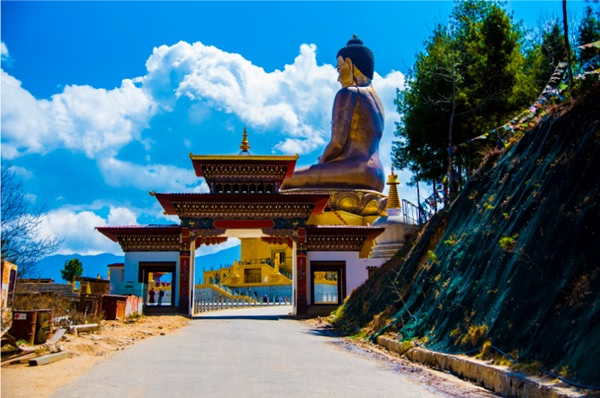
Image Credit : Freepik
Bhutan is one of the most unique countries in the world due to its culture heritage, natural environment, and the government's policies. And that's why travelling to Bhutan is considered a once in a lifetime experience by many. Aside from the must-visit places in Paro, there are also many exciting places to visit in Thimphu.
What's Unique About Thimphu?
Thimphu is the bustling capital of Bhutan, and it is only one hour drive from Paro International Airport. The capital city has a perfect blend of modernization and tradition. In spite of globalization, Bhutan has managed to retain its unique culture and identity.
These strong cultures can be seen through some exploration and strolling in Thimphu town. Buildings are built with traditional architecture and locals are seen wearing traditional costumes on a daily basis.
Thimphu is located 8,688 ft. above sea level and has a population of approximately 100,000 people in a Kingdom of approximately 760,000. This makes Thimphu the most populous district in Bhutan.
One of the most remarkable facts about this city is that there is not a single traffic light to be found. Yet, locals are operating and functioning in an orderly manner. There are a lot more things that you will discover when you visit this city which is why it’s also a sought-after tourist destination in the world.
1. Buddha Dordenma
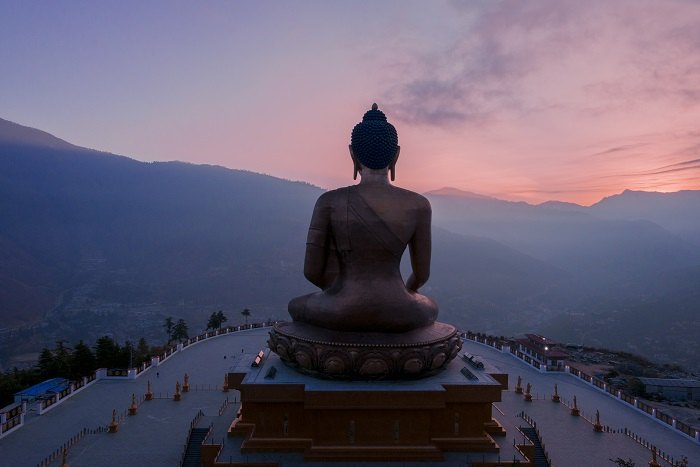
Buddha Dordenma, also known as Buddha Point, is definitely a popular attraction in Bhutan. This 51.5-meter-high sitting Buddha statue is one of the largest sitting Buddha statues in the world.
The Buddha Dordenma statue is made of solid bronze and gilded with gold paint. It includes all of the 125,000 smaller Buddha statues placed within the large statue: 100,000 statues that are 8 inches tall and 25,000 statues that are 12 inches tall.
Visitors can enter a majestic meditation hall with beautifully carved pillars painted in gold and a gold statue of the four-faced Buddha. The walls are elegantly painted with murals of Buddhism. From Buddha Point in Thimphu, you can also have an overview of the city.
2. Tashichho Dzong
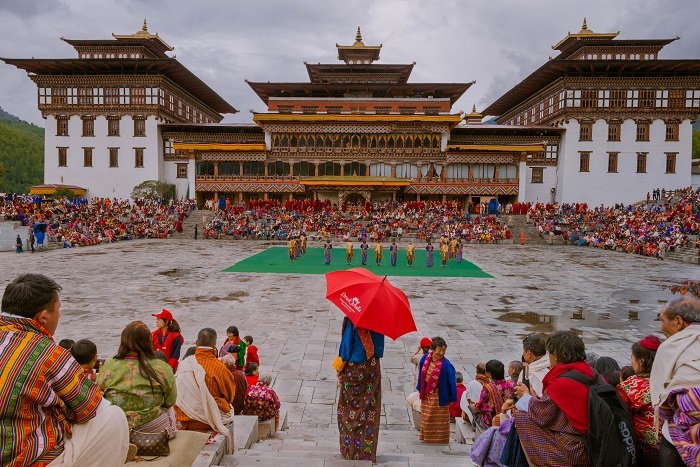
Tashichho Dzong (fortress), commonly known as Thimphu Dzong, is an impressive structure situated in the northern part of Thimphu City.
Tashichho Dzong has been the seat of the government since 1952 and currently houses the throne room and offices of the king, the secretariat, and the ministries of home affairs and finance.
As a tourist, you will not be allowed to visit the Royal and government offices, but you can certainly visit the monastery and admire the marvelous architecture and surroundings of the dzong.
One of the most prominent things you will notice upon arriving at the dzong would be the Bhutan national flag flying splendidly outside the building.
If you visit Bhutan from April to July, you will see a stretch of colorful rhododendron flowers greeting you along the pathway. Or if you visit in March, you may also be in luck to see the blooming cherry trees!
3. Jungshi Handmade Paper Factory
One of the popular things to do in Thimphu is to pay a visit to Jungshi Handmade Paper Factory to witness the making of authentic Bhutanese paper known as deh-soh. These sehsoh are produced using the traditional method that has been practiced for many generations.
This ancient craft is one of the thirteen traditional arts of Bhutan that is still being preserved. The barks of the daphne tree and dekap tree are used to manufacture the papers. Deh-sho papers were originally used in monasteries for woodblocks, manuscripts, and writing of prayer books.
You can try your hand at this ancient craft. You can also find other products like stationery and greeting cards that will make unique souvenirs.
4. Royal Textile Academy
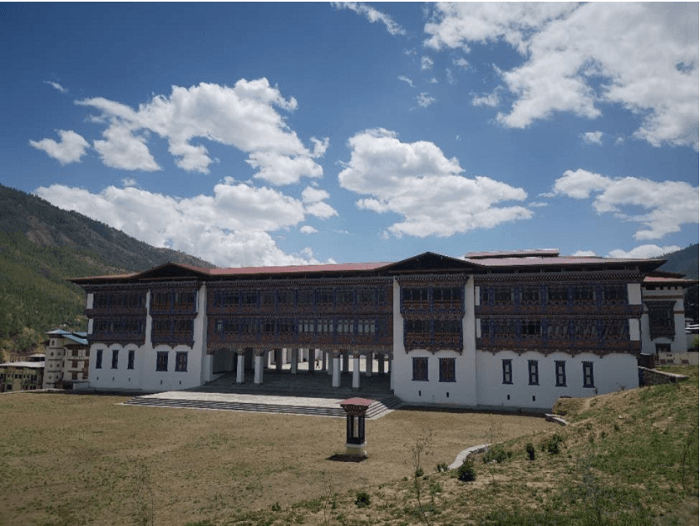
Weaving is an integral part of the Bhutanese culture and tradition. Through the Royal Textile Academy, you will be able to learn about the textile heritage, different weaving styles and the intricacies of the Bhutanese textile.
You will get to see the different intricate patterns of the Bhutanese textiles and learn about the patterns that originated from the different districts. Upon visiting the center, you will be able to better appreciate the beautiful traditional costumes, Kira and Gho, that you see the locals wear on the street.
5. Simply Bhutan
Simply Bhutan is an interactive museum that offers you an excellent guided introduction to different aspects of the traditional Bhutanese life. This place is a great place for your induction to Bhutan.
For instance, you will learn how to dress up in traditional Bhutanese clothes and how to distill ara (rice wine). You will also enjoy some local butter tea, watch the local dance performance, and learn how they construct their beautiful homes out of rammed earth.
The infrastructure in this museum primarily portrays the ancient Bhutanese architecture. The structure of the museum itself is built reusing old timber, door and window frames and numerous other materials from demolished houses.
Unlike most museums where you aren't allowed to touch the artifacts or take photographs, you are free to snap away freely here. You can also try a hand at the archery and the local dart game known as Khuru. You will also get to meet Pema Tshering, a talented foot artist who is diagnosed with cerebral palsy.
There is a little shop inside Simply Bhutan where Pema does his wood carving and painting using his foot. If you see him, don't hesitate to say hello and support his artwork; he will be greeting you with his dazzling smile for sure!
6. Folk Heritage Museum
This museum is another popular place to visit in Thimphu. The Folk Heritage Museum is set inside a three-storeyed 19th-century traditional house. The museum provides visitors with a glimpse of traditional Bhutanese lifestyles and artifacts in a traditional household. You will see a collection of household objects, tools, and equipment in a typical Bhutanese home.
The museum perfectly recaptures the rural setting and ambiance of a traditional household as you get to witness the paddy, wheat, and millet fields set up, a traditional water mill with mill stones that is more than 150 years old, as well as traditional kitchen gardens and hot stone baths that are famous throughout the country.
Visiting the museum will definitely allow you to learn more about the local culture, customs, and traditions.
7. Motithang Takin Preserve
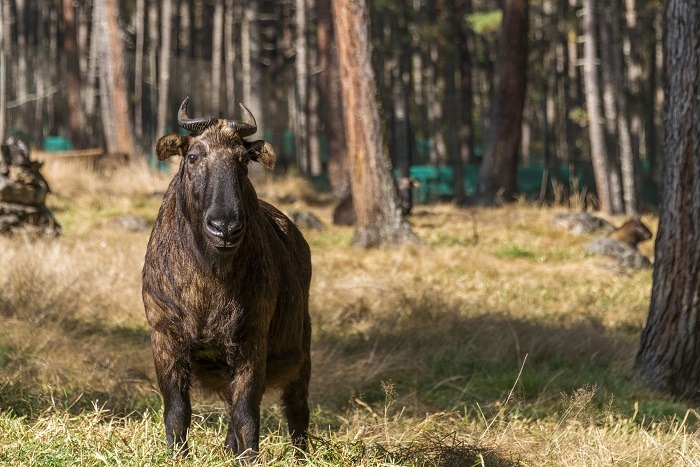
The Takin Preserve is a wildlife reserve area for Takin, the national animal of Bhutan. It's also commonly known as the Takin Enclosure of Takin Zoo.
The mini zoo was converted into a preserve when it was found that the Takin refrained from inhabiting the surrounding forest even when set free. The declaration of Takin as the national animal was related to the local myth from the 15th century.
The famous Tibetan saint Drukpa Kunley, popularly known as the “Divine Madman,” is said to be responsible for the creation of this unique creature called Takin, a gnu goat that resembles an ox but is more closely related to a sheep.
Some have claimed that Takin is one of the most queer-looking animals that they have ever seen! Tips: After visiting the Takin Preserve, request for your guide to bring you to the BBS Tower.
Just a 5 to 10-minute drive to the upper part of the road will lead to Sangaygang BBS (Bhutan Broadcasting Station) Tower at 2,685 meters. The bird's eye view of the entire Thimphu city will be your splendid photo background. You will get to see a lot of colorful prayer flags surrounding the BBS tower.
8. Bhutan Postal Museum
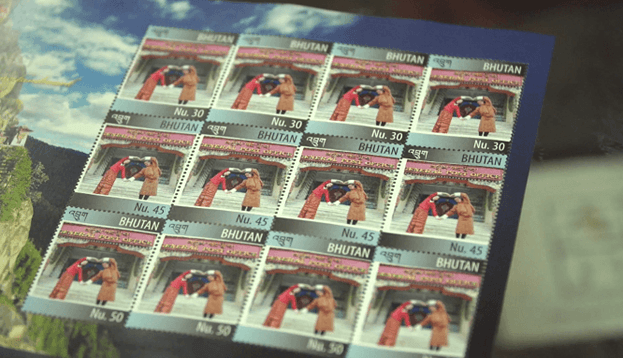
The Bhutan Postal Museum is home to the world's largest photo book and the most bizarre collection of Bhutanese stamps that will intrigue any philatelist.
There are five galleries in the museum that trace the development of the Bhutanese postal system, from the earliest mail runners to Bhutan's often unusual and highly collectible stamps.
One of the most interesting things to do in Thimphu, Bhutan, is to get your own personalized legitimate stamps at the General Post Office for 500 Ngultrum (around USD7). It contains 12 stamps with a mixed value of 30 Ngultrum, 45 Ngultrum, and 50 Ngultrum.
Go ahead to pick up some postcards, start sending some greetings, and share some Bhutan love with your family and friends! Imagine the pleasant surprise of your family and friends when you send them a postcard with your face on the stamp!
9. National Memorial Chorten

National Memorial Chorten is a prominent stupa erected in 1974 in honor of the father of modern Bhutan, the third king of the country, His Majesty Jigme Dorji Wangchuck. The stupa is a prominent landmark located in the heart of Thimphu city with its golden spires and bells.
The Memorial Chorten is designed as a Tibetan style chorten, also called the Jangchup Chorten, and has the design of a classical stupa pattern, with a pyramidal pillar crowned by a crescent moon and sun.
The distinctive feature of the chorten is the outward flaring of the rounded part giving it a pyramidal shape of a vase. Do always remember to circumambulate in a clockwise direction while you are there, as with any religious structures in Bhutan.
You can see many elderly Bhutanese hanging out near the large prayer wheels, catching up with one another or offering prayers with the prayer beads clutched in their hands.
10. Simtokha Dzong
Simtokha Dzong is the first ancient fortress to be built in the Kingdom and the first building to incorporate both monastic and administrative centers. The central tower is three storeys high, with prayer wheels surrounding the courtyard.
One of the interesting features of the dzong is that there are more than 300 slate carvings depicting Buddhist figures.
Today, it also houses one of the top-ranking Dzongkha language institutes aside from being an important Bhutan's historical monument. Visiting Simtokha Dzong will allow you to gain insights into Bhutan's early days.
11. Clock Tower Square
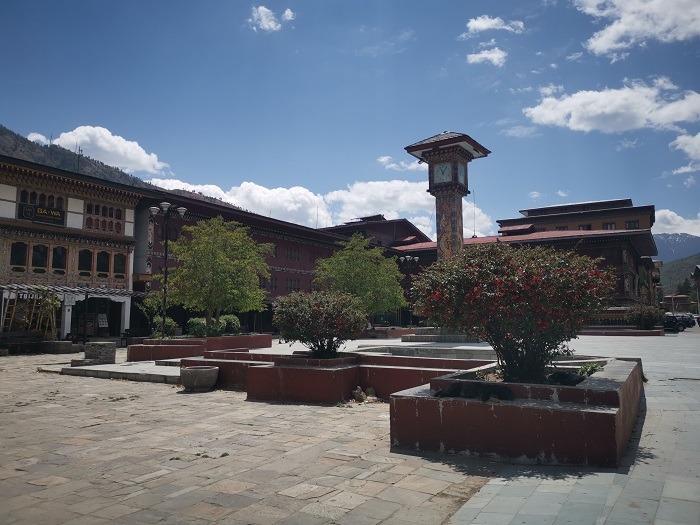
The Clock Tower in Bhutan is a beautiful structure with really nice Bhutanese carvings and paintings. There are traditional hand-crafted dragons with golden paintings on all four faces of the tower which symbolizes the country as an independent dragon kingdom.
There are various shops, cafes and restaurants around the clock tower square that you can explore. Occasionally, there will also be public events and performances held at the clock tower square.
12. Coronation Park
The Coronation and Centenary Park was built to honor the fifth king, His Majesty Jigme Khesar Namgyal Wangchuck. Ashi Chimi Yangzom Wangchuck inaugurated the Centenary and Coronation Park on 26 September 2006.
It is positioned in the middle of Changlimithang ground and Wangchu River. It is built on an area of 5.6 acre of land running along the banks of river Wangchu. It is a nice place for a picnic.
13. Changangkha Lhakhang
Changangkha Lhakhang is one of the oldest and most beautiful temples in the capital city. If you are a spiritual person who wants to seek blessings, you should check out Changangkha Lhakhang.
It is famously known as a 'name-giving temple' as newborns are brought here by their parents, and the resident astrologers will give an appropriate name to the child based on its date and time of birth and astrology.
The temple sanctum sanctorum has a beautiful 11-headed statue of Lord Avalokiteswara. The temple is located on a small hillock, about 50 steps above ground, and provides a stunning view of Thimphu town.
14. Tango Monastery
On the northward side of the capital is the magnificent Tango monastery. It is at least a 30-minute drive from the main Thimphu town, and after reaching the Dodena area, you will need to hike for an hour to reach the monastery.
This ancient monastery was founded by Phajo Drugom Zhigpo in the 12th century but was constructed in the 18th century by the 4th temporal ruler Druk Rabgye in 1688. There are many superb wall paintings from the 17th century, and you can see monks studying Buddhism in the building.
This is one of the few monasteries in Bhutan that still stand in its original condition.
15. Phajoding Monastery
Just a three-hour hike away, you will be able to traverse through blue pine forest and explore the 13th-century monastery. Journey towards the monastery is a 5km arduous uphill hike from the youth center in Motithang. But the hike is extremely rewarding, with amazing views of Thimphu city.
Along the way, you will be able to see a variety of flowers and plants including the golden mushroom. On a clear day, you will also be able to get a breathtaking view of the eastern Himalayas.
16. Thimphu Valley
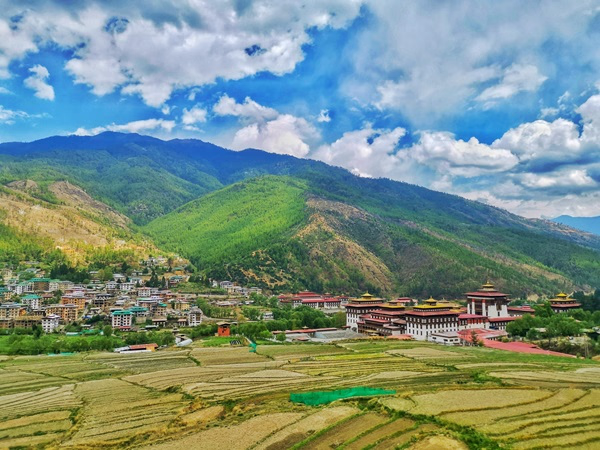
Thimphu Valley, nestled in the heart of Bhutan's capital, is a vibrant blend of traditional and modern Bhutanese culture. The valley is surrounded by lush green hills and offers picturesque views of terraced fields, traditional homes, and sacred temples.
Thimphu Valley is the cultural and political center of Bhutan, offering visitors a unique opportunity to experience the country's rich heritage.
The valley is home to key attractions, including the Buddha Dordenma statue, bustling markets, and vibrant festivals like the Thimphu Tshechu. The serene environment, coupled with the chance to observe daily Bhutanese life, makes it a captivating destination for travelers.
17. Royal Botanical Garden
The Royal Botanical Garden, located in Serbithang, near Thimphu, is a sprawling green oasis that showcases the rich biodiversity of Bhutan. The garden features a wide variety of native plant species, including rare orchids, medicinal plants, and vibrant rhododendrons.
This botanical haven provides a serene escape from the bustling city, allowing visitors to immerse themselves in Bhutan's natural beauty.
The garden offers well-maintained walking paths, informative displays, and a tranquil environment perfect for nature lovers and photography enthusiasts. It's also an excellent spot for picnics and leisurely strolls.
18. National Library
The National Library of Bhutan, located in Thimphu, is an architectural gem that houses a vast collection of ancient manuscripts, religious texts, and historical documents. The library's traditional Bhutanese design, complete with intricate carvings and vibrant murals, makes it a cultural treasure.
As a repository of Bhutan's literary and cultural heritage, the National Library offers visitors a deep insight into the country's history, religion, and traditions. The library's collection includes the world's largest published book, making it a fascinating destination for book lovers and history buffs alike.
19. Thai Style Pavilion
The Thai Style Pavilion, also known as the Thai Bhutan Friendship Park, is a unique cultural landmark near the Kuensel Phodrang Nature Park in Thimphu. The pavilion, gifted by Thailand to Bhutan, features elegant Thai architectural elements and is surrounded by beautifully landscaped gardens.
This pavilion symbolizes the strong friendship between Thailand and Bhutan and offers a peaceful setting for relaxation and reflection.
Visitors can enjoy panoramic views of Thimphu, visit the nearby Buddha Dordenma statue, and explore the cultural ties between the two nations. This Thai temple in Thimphu has a serene ambiance and beautiful surroundings, making it a delightful spot for tourists.
20. Dechen Phodrang
Dechen Phodrang, meaning "Palace of Great Bliss," is a historic monastery located at the northern end of Thimphu. It houses a monastic school and is renowned for its ancient murals and beautiful Bhutanese architecture.
Dechen Phodrang offers a glimpse into Bhutan's spiritual life and serves as an important religious center.
The monastery's peaceful atmosphere, combined with its historical significance and stunning views of the Thimphu Valley, makes it an ideal destination for those seeking spiritual and cultural enrichment. The opportunity to observe young monks in their studies and rituals adds to the monastery's charm.
21. Tashi Chho Dzong
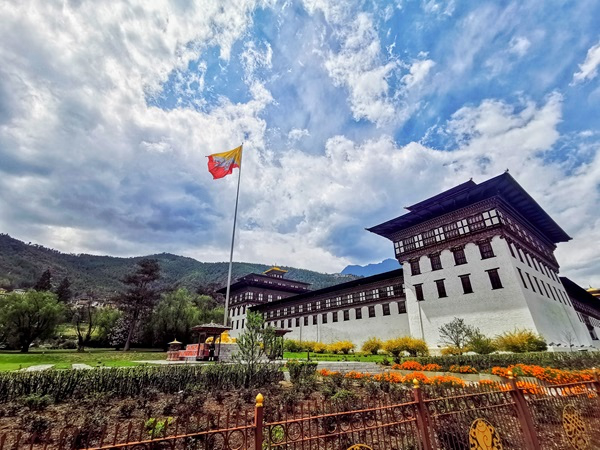
Trashi Chho Dzong, also known as Tashichho Dzong, is a majestic fortress and monastery located on the banks of the Wang Chhu River in Thimphu. It serves as the administrative center of Bhutan and the summer residence of the monastic body.
This iconic dzong is an architectural marvel, blending traditional Bhutanese design with modern elements. It is home to the throne room and offices of the King of Bhutan, making it a symbol of the nation's political and spiritual life.
Visitors can explore the dzong's beautiful courtyards, intricate murals, and grand halls. The annual Thimphu Tshechu festival, held at the dzong, offers a vibrant display of Bhutanese culture through mask dances and religious performances, making it a must-visit event for cultural enthusiasts.
If you want to check out those awesome places in Thimphu, you should consider taking a 7-Day Essential Bhutan Travel Plan or spend 10 days to discover Bhutan. You may also check the best time to visit Bhutan. Check out our tips when you're planning a trip to Bhutan.
Conclusion About The Top Places To Visit In Thimphu Bhutan
Thimphu, the capital city of Bhutan, offers a unique blend of tradition and modernity, making it a captivating destination for travelers. The city's rich cultural heritage, stunning landscapes, and spiritual sites provide a memorable experience for visitors.
Discover Thimphu's top places with our Bhutan travel packages. Plan your visit by understanding the best time to travel to Bhutan and the Bhutan travel cost. For a luxurious journey, consider our luxury travel in Bhutan. If you're coming from Malaysia, our guide on travel to Bhutan from Malaysia will be helpful. Druk Asia, the best Bhutan travel agency, is dedicated to making your trip extraordinary.
Frequently Asked Questions About The Top Places To Visit In Thimphu Bhutan
What Are Some Unique Things To Do In Thimphu?
Unique things to do in Thimphu include visiting the National Folk Heritage Museum, exploring the Centenary Farmers' Market, and hiking to Tango Monastery.
Is It Possible To Visit All The Major Places In Thimphu In One Day?
While it's possible to visit several major sites in one day, it's recommended to spend at least two days to fully experience the city's attractions.
Are There Any Outdoor Activities Available In Thimphu?
Yes, outdoor activities in Thimphu include hiking, trekking, bird watching, and nature walks in the surrounding hills and parks.
What Cultural Experiences Can I Have In Thimphu?
Cultural experiences in Thimphu include attending traditional dance performances, visiting temples and monasteries, and exploring local crafts at The Craft Gallery.
Are There Any Festivals In Thimphu That I Should Attend?
The Thimphu Tshechu, a major religious festival featuring masked dances, is a must-attend event held annually in the autumn.
What Are The Best Places To Shop For Souvenirs In Thimphu?
The Craft Gallery, Chhom Bhutan and local markets are great places to shop for traditional Bhutanese souvenirs.
